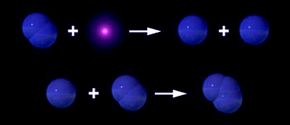How the Ozone Layer Forms and Protects
Most ecosystems rely on the ozone to protect them from harmful ultraviolet (UV) light. If you know much about the light spectrum, you'll remember that the varying wavelengths of light determine the color or kind of light. Ultraviolet light falls outside of the range of light that's visible to the human eye, much like microwaves, X-ray and radio waves.
When it comes to UV light, what we don't know (or don't see) can hurt us. UV light from the sun's rays burns our skin and freckles our noses when we're outside on a sunny day. But skin blemishes are the least of our worries. Exposure to UV light can lead to skin cancer and cataracts, and can damage the body's immune system [source: EPA].
Advertisement
Thankfully, the ozone layer protects us from most of the sun's harmful UV rays. Ninety percent of the atmospheric ozone is in the earth's stratosphere -- the altitude starting at six to 11 miles (9.6 to 17.7 kilometers) above the earth and extending to about 30 miles (48.3 kilometers) above the earth [source: Fahey]. The stratosphere provides a natural setting conducive to the formation of the ozone, where gas forms a protective layer that completely envelops the earth.
Ozone gas forms in the stratosphere when UV sunlight hits oxygen gas in what is known as the ozone-oxygen cycle:
- The first stage of this cycle occurs when short-wavelength UV light from the sun hits a molecule of oxygen gas. The light has so much energy that it breaks the oxygen bond holding the atoms together, thus creating two oxygen atoms. Through this process, the oxygen essentially absorbs the short-wavelength UV light, but this still leaves a significant amount of UV light with longer wavelengths, which is where ozone comes in.
- In the second stage, each of the two remaining oxygen atoms will then latch onto two oxygen gas molecules, creating two separate ozone molecules [source: Fahey].
- Short-wavelength UV light has enough energy to break apart ozone molecules (which are more volatile and easier to separate than oxygen molecules). Thus, in the third stage of the cycle, the ozone gas then breaks into one oxygen gas molecule and an oxygen atom, hence absorbing much of the remaining UV light.
If you're wondering why these processes "absorb" UV light, it is because they create exothermic reactions, meaning they release heat. Essentially, oxygen and ozone convert UV light to heat. Together, ozone and oxygen gas are effective at absorbing about 98 percent of the harmful UV light [source: Sparling].
On the next page, we'll discuss the different methods and instruments scientists use to measure ozone levels in the ozone layer.
